
Ham's pet Chemistry is a true enigma. He was found in South America where there are not true apes known to mundane science, yet he is tailless and bulky enough to be almost a dead ringer for Monk albeit somewhat smaller. He apparently walks up right. He is called in the Super Sagas an ape, a goriboon, a whatsis, and other vague terms. What was clear was that he was a species hitherto unknown to science. So what was he? A kind of chimpanzee? A baboon? A tailless New World Monkey? Or a throwback to one of our early ancestors?
This is the best description of Chemistry that we have. It is taken from the Super Saga "Dust of Death" in which he is first introduced:

It was a monkey. But such a monkey. It was larger than a chimpanzee, but smaller than a gorilla. It had no tail and its hair was rust colored. Strangest of all was the astounding resemblance the newcomer bore to Monk.
Lester Dent was not a zoologist and it is not clear to me that he knew the difference between an ape and a monkey. But there is a BIG difference. There is a very large evolutionary gap between apes and monkeys and several anatomic and behavioral differences. You cannot mistake one for the other if you know what to look for.
Apes apparently arose from a common ancestor with the monkeys about 22 million years ago. Most monkey species have tails, but no apes or hominids do. Monkeys are much more like other mammals than apes and humans are. For example, most monkeys cannot swing from branch to branch, as apes and humans can, because their shoulder bones have a different structure. Instead, monkeys run along the tops of branches. Their skeletal structure is similar to a cat, dog, or other four-footed animal, and they move in the same sort of way. Apes and humans rely more on vision than smell, and their noses are short and broad, rather than snout-like. Apes like humans are capable of creating tools and using language. Monkeys have a very limited set of calls and screams like other mammals but they lack the sophistication we see in ape and human communication. Apes like humans have complex social lives and are capable thinkers and problem-solvers. Monkeys like most other mammals have a relatively simple social structure. Monkeys have a deep chest like cats and dogs while apes have a broad chest like humans. The arms and legs of monkeys are nearly equal in length while apes have arms that are longer than their legs. Australopithecines -- an extinct form of hominoid -- and humans have legs that are longer than their arms. Monkeys are usually smaller than apes and definitely smaller than humans. The only exception to this rule are some of the apes known as gibbons. The smallest gibbon species are smaller than the largest monkeys. Finally, apes have no hair on their faces whereas monkeys like other mammals usually do. Human type facial hair (i.e. the male beard and moustache) and scalp hair which grows continuously to great lengths is not found in other apes nor in most monkeys. Monkey facial hair patterns are different from those found in humans.
In short, the animal we know as Chemistry is NOT a monkey. It is clearly ape-like and must be considered an anthropoid.
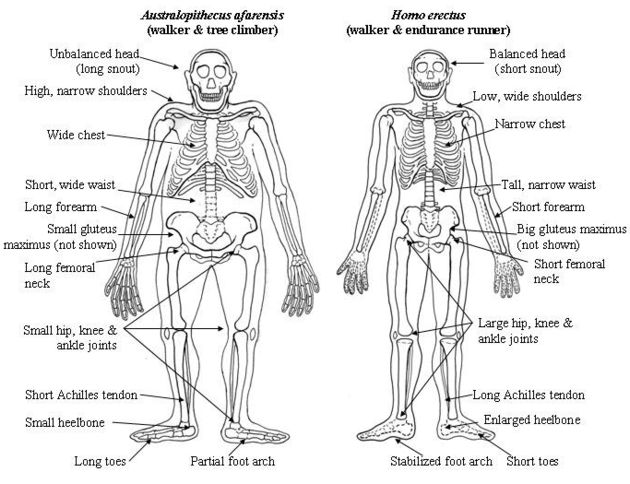
Could Chemistry have been an Australopithecine? No. Chemistry was said to look like Monk with arms longer than his legs. Australopithecines were upright bipedal walkers on the ground (though their gait was different from a human's gait) and their arms were slightly longer in proportion to their legs than we find in hominids (i.e., human species). But their arms were not longer than their legs and they could not knuckle-walk. They had a pelvis designed for upright walking. Their feet were man-like and not adapted to power gripping like those of an ape or monkey, but their toes were longer and they could grab a foothold on a branch more reliably than a man. It does appear from their shoulder joints that they were partially arboreal.

Could Chemistry have been a Mangani, one of the Great Ape species that raised Tarzan? Again I would say no. The Mangani are confined to Africa and have not been found in the New World. Tarzan made a clear distinction between the Mangani and the Bolgani (i.e., gorillas). Monkeys were "manu" and baboons were tongani. In fact, the Great Apes counted themselves among human species, not ape species. The word "Tarmangani" means "white man", while "Gomangani" means "black man", "Malmangani" means "yellow man", "Balmangani" means "golden/tan man", and "Gamangani" means "red man". Chemistry was ape-like and not a hominid. For all of these reasons, he could not have been Mangani.
Curiously, there was no Great Ape word for Chimpanzee. For some reason -- possibly because of their physical similarities -- I suspect that the Great Apes conflated chimps and gorillas into one category, Bolgani.
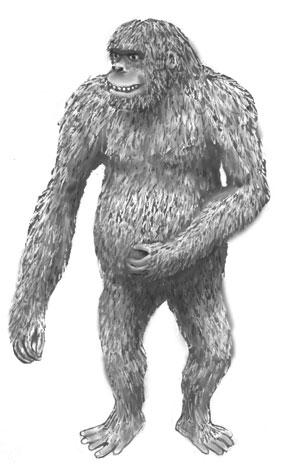 Portrait of a full grown male Mangani
Portrait of a full grown male Mangani
So what were the Great Apes? Likely they were a very large form of Australopithecine with the males averaging 7 feet in height and weighing ~650 pounds. Very likely this Australopithecine was descended from a gracile Australopithecine ancestor which it shared in common with humans and not from the separate line of robust Australopithecines that branched off earlier and went extinct. Note the stunted first toe in the portrait above. This indictes an attempt to return to an arboreal way of life with an increased grippng capability in the foot. The Second toe has become the longest and becomes the point of active push off when ambulating on the ground.
 Portrait of a full grown male Mangani
Portrait of a full grown male ManganiSo what were the Great Apes? Likely they were a very large form of Australopithecine with the males averaging 7 feet in height and weighing ~650 pounds. Very likely this Australopithecine was descended from a gracile Australopithecine ancestor which it shared in common with humans and not from the separate line of robust Australopithecines that branched off earlier and went extinct. Note the stunted first toe in the portrait above. This indictes an attempt to return to an arboreal way of life with an increased grippng capability in the foot. The Second toe has become the longest and becomes the point of active push off when ambulating on the ground.
This creature would have been so close to the human lineage that it shared the human nutritional requirement for exogenous sources of Vitamin C and thus would have had Vitamin C in its milk. This was a critical nutritional problem that Edgar Rice Burroughs would not have known about. All of the true apes - gibbons, orangs, chimps and gorillas - can manufacture their own Vitamin C in the liver and hence do not include it in their milk. Only man and the guinea pig among the mammals cannot synthesize Vitamin C and thus require Vitamin C in the diet, especially in the milk which is the only food for infants for at last the first 6 months of life in primitive settings. If Kala had not had Vitamin C in her milk when she nursed Tarzan, he would have died of scurvy rather quickly.
The pattern of arms-longer-than-legs we see in Chemistry is an adaptation to an arboreal lifestyle in a creature too heavy to stand on small branches. It facilitates hanging down from branches and swinging from branch-to-branch in the trees. When such creatures walk on the ground they can use a style of locomotion called "knuckle-walking" because their arms can reach the ground without their having to bend too far over. They lean forward while remaining upright and put some weight on the 2nd and 3rd metacarpal-phalangeal joints (i.e., the knuckles of the index and middle fingers) of both hands. This four limbed posture is typical of chimps and gorillas. Orangutans rarely walk on the ground and their arms are too long for knuckle-walking. Gibbons are likewise almost completely arboreal and have long arms which cannot be used for knuckle-walking. They tend to walk upright on the ground for short distances or scurry on all fours using their arms like a human using crutches.
Whatever species Chemistry belonged to, he was ape-like in bodily structure and used a knuckle-walking gait. He also seems to have had gripping feet like an ape.
But there are no true apes in the New World. The rumors about Bigfoot, Sasquatch, and other large hairy hominids and anthropoids in the Americas remain unsupported. And there is no fossil evidence of any extinct New World apes. So where did Chemistry come from?
I suggest that Chemistry and his kind were fugitives from Maple White Land. We know from Sir Arthur Conan Doyle's account in The Lost World that there were more than just dinosaurs on that plateau. He mentions extinct tertiary mammals like Irish Elk (Megaloceros giganteus), along with a tribe of "ape-men" (likely Homo Habilis) neither of which were ever found in the New World. There were also other mammals (Glyptodon and Toxodon) and at least one large bird (Phorusrhacos) which were not contemporary with dinosaurs. It seems that extinct creatures from many eras and places from around the globe were "mixed" on that plateau. This hints at a deliberate breeding program, not a natural preservation of extinct flora and fauna. Someone or something had collected long dead species from all over the world and set them loose on that plateau. It is interesting that we see a similar pattern of mixed fauna on Thunder Island in the Super Saga The Land of Terror. Were the two place stocked by the same being or beings?
It is therefore possible that Chemistry represents a resurrected species of extinct ape larger than a chimp but smaller than a gorilla that escaped from the Maple White Land "game preserve". I would suggest that Chemistry was most likely a member of the genus Dryopithecus or a similar closely related species.
The pattern of arms-longer-than-legs we see in Chemistry is an adaptation to an arboreal lifestyle in a creature too heavy to stand on small branches. It facilitates hanging down from branches and swinging from branch-to-branch in the trees. When such creatures walk on the ground they can use a style of locomotion called "knuckle-walking" because their arms can reach the ground without their having to bend too far over. They lean forward while remaining upright and put some weight on the 2nd and 3rd metacarpal-phalangeal joints (i.e., the knuckles of the index and middle fingers) of both hands. This four limbed posture is typical of chimps and gorillas. Orangutans rarely walk on the ground and their arms are too long for knuckle-walking. Gibbons are likewise almost completely arboreal and have long arms which cannot be used for knuckle-walking. They tend to walk upright on the ground for short distances or scurry on all fours using their arms like a human using crutches.
Whatever species Chemistry belonged to, he was ape-like in bodily structure and used a knuckle-walking gait. He also seems to have had gripping feet like an ape.
But there are no true apes in the New World. The rumors about Bigfoot, Sasquatch, and other large hairy hominids and anthropoids in the Americas remain unsupported. And there is no fossil evidence of any extinct New World apes. So where did Chemistry come from?
I suggest that Chemistry and his kind were fugitives from Maple White Land. We know from Sir Arthur Conan Doyle's account in The Lost World that there were more than just dinosaurs on that plateau. He mentions extinct tertiary mammals like Irish Elk (Megaloceros giganteus), along with a tribe of "ape-men" (likely Homo Habilis) neither of which were ever found in the New World. There were also other mammals (Glyptodon and Toxodon) and at least one large bird (Phorusrhacos) which were not contemporary with dinosaurs. It seems that extinct creatures from many eras and places from around the globe were "mixed" on that plateau. This hints at a deliberate breeding program, not a natural preservation of extinct flora and fauna. Someone or something had collected long dead species from all over the world and set them loose on that plateau. It is interesting that we see a similar pattern of mixed fauna on Thunder Island in the Super Saga The Land of Terror. Were the two place stocked by the same being or beings?
It is therefore possible that Chemistry represents a resurrected species of extinct ape larger than a chimp but smaller than a gorilla that escaped from the Maple White Land "game preserve". I would suggest that Chemistry was most likely a member of the genus Dryopithecus or a similar closely related species.

Dryopithecus was an early common ancestor of the African great apes, the Australopithecines, and humans with a brain proportionate in size to a chimp. It also had many characteristics that were intermediate between the great apes and upright hominoids. Fossils of this creature are found in the early to mid Miocene era between 20 million and 11 million years ago. It had a large jaw and well developed canines and retained prehensile feet. The fossil specimens indicate a creature that was only 2 feet tall which weighed about 50-75 pounds, but larger species could have existed of which we are unaware. There were at least 100 species of extinct apes in the Miocene era and there could have been many more.
The average male chimpanzee weighs between 90 and 115 pounds and is 3 to 4 feet long. An average gorilla male would be 6 foot 6 and weigh ~500 lbs. Since Chemistry was larger than a chimp and smaller than a gorilla, he was likely 5 feet long and ~180 lbs. Because of his stooped posture, he would ordinarily seem shorter than he was. But he would have been very strong. Likely he would have been even stronger than Monk! No one would be carrying this "monkey" around.

So I suggest that Chemistry was a member of a giant species of the genus Dryopithecus whose tribe had escaped from Maple White Land. Likely, they never made a go of it and are now extinct in the wild. But there may still be some of these apes on Maple White Land.




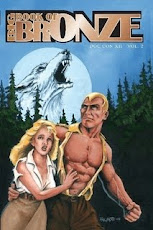



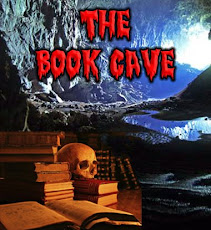


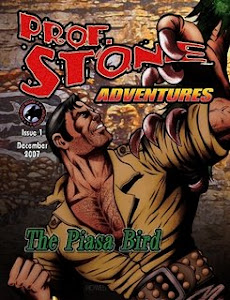


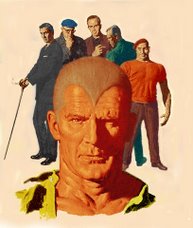

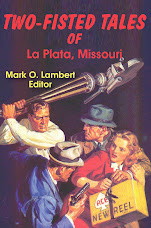
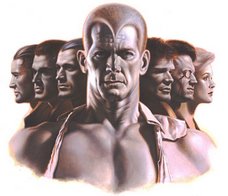


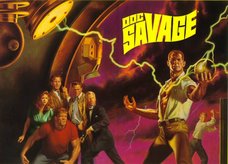





No comments:
Post a Comment